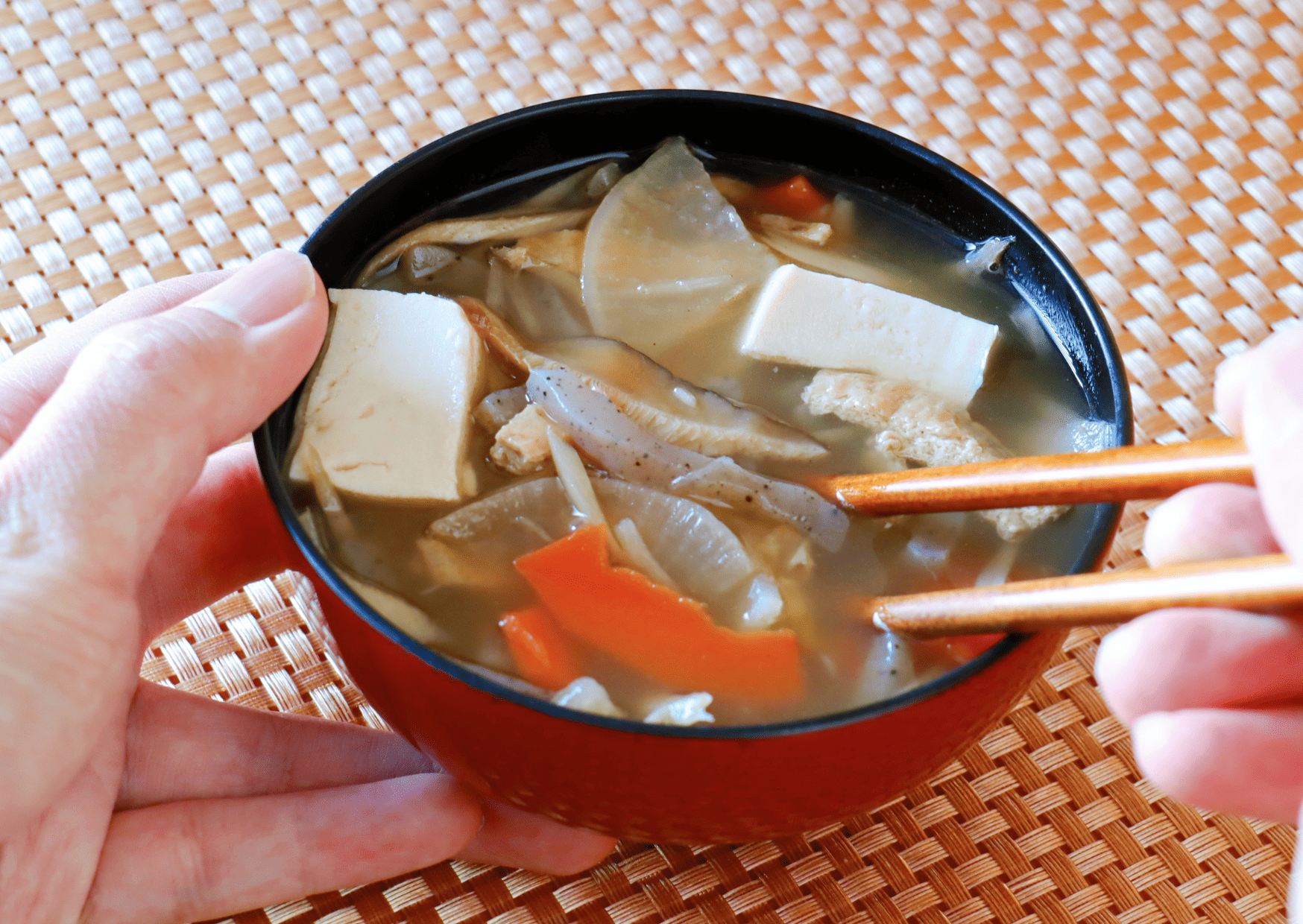Last updated on March 25th, 2024 at 02:12 am

Vegetarian in Japan and looking for the best vegetarian dishes in Japan to try?
Japan, a country renowned for its rich culinary traditions, has slowly but surely begun to embrace the vegetarian lifestyle. The land of sushi, tempura, and ramen might seem challenging for vegetarians at first glance, but there are an increasing number of options available that cater to those who prefer a plant-based diet. Read here Vegan food in Kyoto and Japan Vegan Snacks
Whether it’s traditional dishes that have always been meat-free or new, innovative vegetarian creations, Japan offers a delightful array of flavors and textures for vegetarians. This guide will provide insights into vegetarian food in Japan and assist you in navigating this fascinating culinary landscape.
Related Travel Guides:
- Best Japan eSIM for Travel
- Best Breakfast in Japan to Try
- Our Recommended Travel Insurance For Japan
- VPN to Use for Travel
Vegetarian in Japan – Vegetarianism and Japanese Culture
Vegetarianism in Japan is not just a dietary choice but a reflection of cultural values like harmony with nature, simplicity, and mindfulness. It represents a way of living that goes beyond food, encompassing philosophical, ethical, and spiritual dimensions. Below, we explore various facets of how vegetarianism is intertwined with Japanese culture:
- Buddhist Influence: Vegetarianism in Japan has deep roots in Buddhism, particularly in the Zen tradition. The concept of Ahimsa, or non-violence towards all living beings, resonates within the vegetarian diet. Shojin Ryori, a traditional Buddhist cuisine, is a manifestation of this philosophy, where cooking itself is a spiritual practice, and the choice of ingredients reflects mindfulness and respect for life.
- Seasonality and Sustainability: Japanese vegetarian cuisine emphasizes seasonality, utilizing fresh, locally-sourced ingredients. This connection to nature’s rhythm not only enhances the taste and nutritional value but also fosters a sustainable relationship with the environment. The Japanese concept of “shun” refers to the precise moment when a vegetable or fruit is at its peak flavor, highlighting the importance of timing and awareness in the culinary experience.
- Artistry and Aesthetics: The presentation of vegetarian dishes in Japan often transcends mere culinary artistry. Each dish is meticulously arranged to stimulate visual, olfactory, and gustatory senses, reflecting the Japanese aesthetic principles of simplicity, elegance, and balance. This artistic expression goes hand in hand with the minimalist philosophy, where less is more, and every element on the plate has significance.
- Health and Well-being: Vegetarianism in Japan aligns with the principles of a healthy lifestyle. The diet focuses on whole, unprocessed foods that are low in saturated fats and high in fiber, vitamins, and minerals. Tofu, seaweed, grains, and vegetables form the foundation of this balanced diet, promoting overall well-being and longevity.
- Cultural Festivals and Celebrations: Certain festivals and cultural practices in Japan revolve around vegetarian food. For instance, during the Obon festival, many Japanese follow a vegetarian diet to honor their ancestors. These traditions link food with spirituality, community, and continuity of cultural heritage.
- Adaptation and Modernization: In contemporary Japan, vegetarianism is also adapting to global influences and lifestyles. From vegan cafes to vegetarian-friendly options in traditional establishments, the landscape is evolving, bridging the gap between age-old practices and modern dietary preferences.
- Tea Ceremony: The traditional Japanese tea ceremony, or Chanoyu, is another aspect where vegetarianism connects with culture. This ritualistic preparation and consumption of matcha (green tea) often include vegetarian sweets and meals. The tea ceremony embodies Zen principles of mindfulness, harmony, respect, and purity.
- Impact on Culinary Techniques: Vegetarianism has also shaped unique culinary techniques in Japanese cooking. From the delicate preparation of tofu to the art of Kaiseki (multi-course meal), the influence extends to various aspects of gastronomy, enhancing creativity, precision, and mastery.
- Challenges and Misconceptions: Despite its rich history, vegetarianism in Japan may also face challenges. The notion of vegetarianism might differ, and some traditional dishes may include fish stock or other non-vegetarian elements. Navigating a strict vegetarian diet may require careful communication and understanding of local customs.
Vegetarian in Japan – Traditional Vegetarian Dishes in Japan
Shojin Ryori

This Buddhist temple food embodies the principle of non-harm. Using seasonal vegetables, tofu, and grains, Shojin Ryori is prepared in a mindful manner, considering balance, color, and arrangement. No animal products are used, including onion and garlic, which are considered to incite passion. The preparation itself is considered a form of meditation and spiritual practice.
Miso Soup
A staple in Japanese cuisine, Miso Soup is made with fermented soybean paste, seaweed, tofu, and sometimes seasonal vegetables like mushrooms and radishes. The salty, savory flavors of miso paste blend harmoniously with the delicate taste of tofu, creating a comforting and nutritious dish that can be enjoyed at any time of the day.
Yasai Sushi

Yasai Sushi, or Vegetable Sushi, is a delightful alternative to traditional sushi, featuring fresh, seasonal vegetables such as avocado, cucumber, asparagus, and pickled radish. Wrapped in seaweed and served with wasabi and soy sauce, Yasai Sushi highlights the natural flavors and textures of each vegetable, providing a colorful and healthful dining experience.
Tempura Vegetables

Tempura is a popular cooking technique in Japan, where vegetables are lightly battered and deep-fried until golden and crispy. Common vegetables used in Tempura include sweet potatoes, carrots, mushrooms, and bell peppers. The light, airy texture of the batter makes this dish delectably crunchy without overpowering the taste of the vegetables.
Nasu Dengaku

Grilled eggplant glazed with miso paste, Nasu Dengaku is a flavorful and rich dish that melts in your mouth. The sweetness of the miso complements the smokiness of the grilled eggplant, creating a satisfying dish that is often enjoyed in the summer months.
Zaru Soba

Made from buckwheat flour, Zaru Soba are cold soba noodles typically served with a dipping sauce made of soy sauce, mirin, and wasabi. Often garnished with shredded nori seaweed and green onions, this refreshing dish is a favorite during hot weather.
Yudofu

A hot tofu stew, Yudofu is gently simmered with kelp and sometimes vegetables like spinach and carrots. It’s a warming and simple dish, highlighting the delicate taste and silky texture of tofu, often served in the winter.
Hijiki Salad

Made from a type of seaweed called hijiki, this salad is often mixed with vegetables like carrots, edamame, and lotus root, and seasoned with soy sauce, mirin, and sesame oil. Hijiki Salad is not only tasty but packed with minerals and fiber.
Kenchinjiru

A hearty vegetable soup, Kenchinjiru originated from Zen Buddhist temples and includes root vegetables, tofu, and sometimes mushrooms. It’s simmered with a kombu dashi base and seasoned with soy sauce and sake, providing a filling and nourishing meal.
Kabocha no Nimono
Simmered pumpkin, or Kabocha no Nimono, is cooked with soy sauce, mirin, and sugar until tender and infused with flavor. The sweet and salty balance makes this a comforting side dish or main course.
Inari Sushi

Named after the Shinto god Inari, who is believed to have a fondness for tofu, Inari Sushi consists of sushi rice stuffed inside sweet, deep-fried tofu pockets. The slightly sweet flavor of the tofu contrasts beautifully with the vinegary rice.
Oshiruko
A sweet red bean soup, Oshiruko is typically served with mochi (rice cakes) or chestnuts. It’s a popular dessert or snack during the winter months, offering a sweet and warm end to a meal.
Kakiage – Vegetarian in Japan
Similar to tempura, Kakiage is a mixture of thinly sliced vegetables and sometimes legumes, coated in a light batter and deep-fried into crispy fritters. Common ingredients include onions, carrots, and green beans.
Yuba
Often referred to as “tofu skin,” Yuba is the thin layer that forms on the surface of soy milk during tofu production. It’s enjoyed in various forms, such as fresh, dried, or cooked in soups, and offers a unique texture and subtle flavor.
Tsukemono

Japanese pickles, or Tsukemono, are a common accompaniment to meals. They can be made from various vegetables like cucumbers, radishes, and cabbage, pickled in salt, vinegar, or rice bran, each imparting a different flavor and texture.
Konnyaku
Made from konjac plant roots, Konnyaku is a jelly-like food that’s low in calories and high in fiber. It can be found in hot pots, stews, or even grilled and seasoned with soy sauce and mustard.
Umeboshi – Vegetarian in Japan
These pickled plums are intensely sour and salty, often served with rice or inside rice balls (onigiri). Umeboshi is considered a natural preservative and is often used in bento boxes.
Seaweed Salad
A medley of different seaweeds, such as wakame, kombu, and agar, the seaweed salad is often seasoned with sesame oil, vinegar, and soy sauce. It’s a refreshing and mineral-rich dish enjoyed across Japan.
Tofu Steak
Pan-fried tofu steaks are often glazed with a savory sauce made from soy sauce, mirin, and garlic. The crispy exterior and tender inside make tofu steak a satisfying and versatile dish, great as a main or side.
Sunomono – Vegetarian in Japan
A vinegared salad often made with cucumbers, seaweed, and sometimes other vegetables or tofu, Sunomono is a tangy and refreshing side dish that cleanses the palate.
Vegetarian-Friendly Establishments in Japan
Several establishments offer vegetarian options. From traditional eateries to modern cafes, here’s a look at some places to find vegetarian food:
- T’s TanTan, Tokyo: Famous for its vegetarian ramen.
- Itosho, Tokyo: A well-regarded place for Shojin Ryori.
- Ain Soph, various locations: A chain offering a wide array of vegan and vegetarian dishes.
- Cafe Bonheur, Kyoto: A charming cafe with vegetarian sweets and snacks.
Final Thoughts on Vegetarian in Japan
Vegetarianism in Japan is a journey of delightful discoveries, where ancient traditions meet modern innovation. While it may require a little effort to find strictly vegetarian dishes, especially in more rural areas, the flavors and variety are rewarding.
Understanding a few key phrases in Japanese or having them written down can make the process much smoother. But rest assured, from the metropolis of Tokyo to the historic streets of Kyoto, vegetarian dining options are there to be explored and enjoyed.
As more people embrace this lifestyle, Japan’s culinary world is expanding and adapting, making it an exciting time to experience vegetarian food in the country. Whether you’re a committed vegetarian or just curious about plant-based Japanese cuisine, this guide serves as your compass to a delicious and fulfilling gastronomic adventure in the Land of the Rising Sun.
About the Author: Ruben, co-founder of Gamintraveler.com since 2014, is a seasoned traveler from Spain who has explored over 100 countries since 2009. Known for his extensive travel adventures across South America, Europe, the US, Australia, New Zealand, Asia, and Africa, Ruben combines his passion for adventurous yet sustainable living with his love for cycling, highlighted by his remarkable 5-month bicycle journey from Spain to Norway. He currently resides in Spain, where he continues sharing his travel experiences with his partner, Rachel, and their son, Han.
